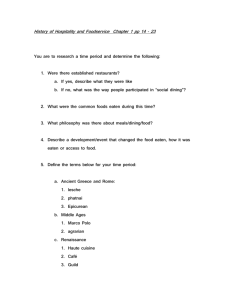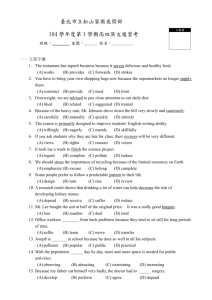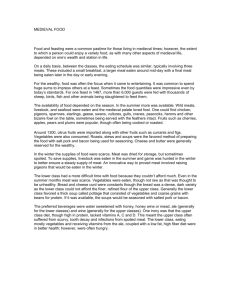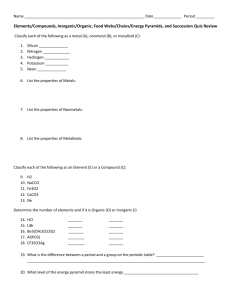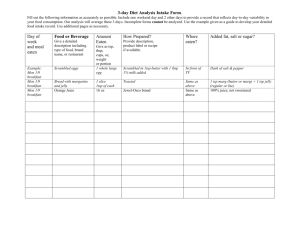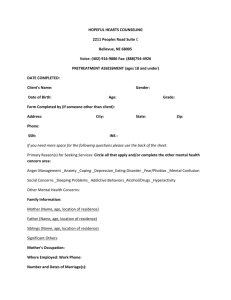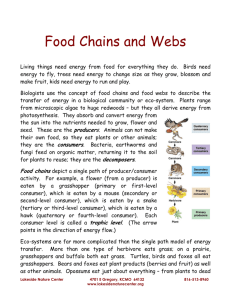Indigenous scoping project – Emerald and surrounds Compiled by Georgia Lloyd Objectives
advertisement
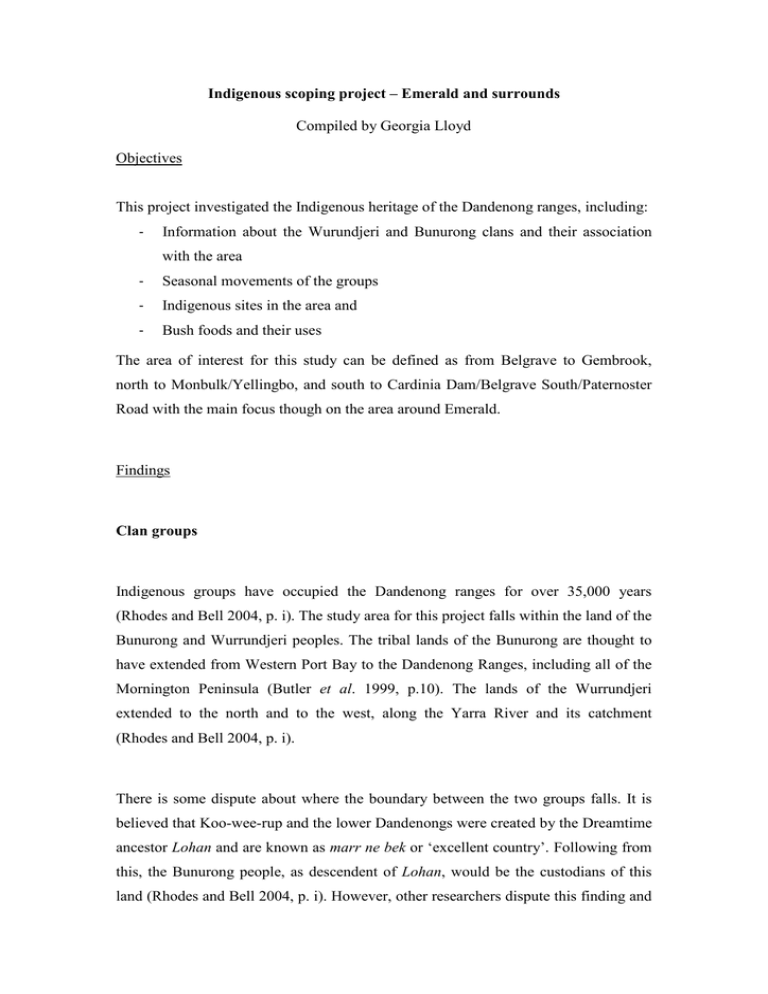
Indigenous scoping project – Emerald and surrounds Compiled by Georgia Lloyd Objectives This project investigated the Indigenous heritage of the Dandenong ranges, including: - - Information about the Wurundjeri and Bunurong clans and their association with the area Seasonal movements of the groups Indigenous sites in the area and Bush foods and their uses The area of interest for this study can be defined as from Belgrave to Gembrook, north to Monbulk/Yellingbo, and south to Cardinia Dam/Belgrave South/Paternoster Road with the main focus though on the area around Emerald. Findings Clan groups Indigenous groups have occupied the Dandenong ranges for over 35,000 years (Rhodes and Bell 2004, p. i). The study area for this project falls within the land of the Bunurong and Wurrundjeri peoples. The tribal lands of the Bunurong are thought to have extended from Western Port Bay to the Dandenong Ranges, including all of the Mornington Peninsula (Butler et al. 1999, p.10). The lands of the Wurrundjeri extended to the north and to the west, along the Yarra River and its catchment (Rhodes and Bell 2004, p. i). There is some dispute about where the boundary between the two groups falls. It is believed that Koo-wee-rup and the lower Dandenongs were created by the Dreamtime ancestor Lohan and are known as marr ne bek or ‘excellent country’. Following from this, the Bunurong people, as descendent of Lohan, would be the custodians of this land (Rhodes and Bell 2004, p. i). However, other researchers dispute this finding and believe that the Wurrundjeri are the traditional owners of this area. Despite this uncertainty it is believed that the Dandenong ranges were a meeting place for the two clans (Butler et al. 1999, p.10-11). The area around Monbulk, where the range separates the rivers that flow north to the Yarra and south to Westernport, is thought to be neutral ground. Members from adjoining Wurrundjeri and Bunurong groups would meet and come together in this area, in which warring was prohibited (Rhodes and Bell 2004, p. ii). This said contact between the two groups was believed to be very harmonious. The Bunurong and Wurrundjeri were known to intermarry and trade and to move freely through each other’s territories for these purposes. Because of their frequent interactions it is supposed that the boundaries between the clans were not rigidly defined (Butler et al. 1999, p.11). Another shared area, referred to by William Barak as the ‘Half-bad country’, was located between the mouth of the Yarra River and inland to Gardiners creek, southwest to the mouth of the Mordialloc Creek and east to Dandenong. This area is believed to have been a shared resource zone for both clans. However because it was formally the land of the Bunurong, Wurrundjeri visitors had to adhere to ritual prohibitions (Rhodes and Bell 2004, p. 30). Movements To reach the neutral area at Monbulk, Bunurong clans moved up the creeks from Westernport and the Wurrundjeri moved south, up the Yarra and its tributaries. Research suggests that Cardinia creek may have been an important travel route between the ranges and the Koo-wee-rup swamp; deep creek and Toomuc creek may also have been used by the Bunurong (Rhodes and Bell, p.32). The movements of the Bunurong and Wurrundjeri groups were seasonal. The Bunurong people moved down from the hills during summer, travelling along major streams towards the Koo-wee-rup swamp, where they would spend the hottest part of the year catching eel (Butler et al. 1999, p.11; p.31). During their travels they would fish for eels and hunt game such as kangaroo, wallaby and wombats. During this time of year they also gathered plants such as murnong (yam daisy), wild raspberries and currants. As they travelled along watercourses they would also eat swamp-dwelling plants such as rushes. Please see Table 1 below for details. In the cooler months the Bunurong would move back inland in order to seek shelter. During their time in the Dandenong ranges they collected and ate the pith of tree ferns and bracken and were also known to hunt lyrebirds (Butler et al. 1999, p.11). Throughout the year, Indigenous people would move around and camp in many areas in order to follow seasonal foods and to prevent resource depletion (p. iii). During these seasonal movements people were known to move in small foraging parties of 20 to 30 individuals (Rhodes and Bell 2004, p.33). These parties would spend between 3 and 10 days at each campsite, and collect resources within a 10 kilometre radius, before moving on (Smith 1991, p.15). Sites of significance Because of their secret and sacred nature there is not much known about Indigenous sites within the Dandenong ranges. One site of importance regularly referenced is Cardinia Creek. As mentioned above, this creek is believed to have been a regular route between the hills and the Koo-wee-rup swamp. One of the most important and regularly frequented points on the creek is at Barnibyrong, located near the St. Germains Homestead (Smith 1991, p.15). This site was known to be visited repeatedly and was marked by midden shell (Gunson 1968, p.10). There are also thought to be several ritual sites in the Dandenongs. One of these sites, located near Clematis, is a rock on ‘Bald Hill’. This area is thought to belong to the Wurrundjeri people, who have been observed placing boughs at the site to ensure a good hunt (Smith 1991, p.15). In addition, it is believed that Monbulk was a place where Aboriginal people brought ill and wounded people to rest beside the healing springs. The site is believed to be located on the property Nathania Spring in Monbulk (Rhodes and Bell 2004, p. 36). A series of artefact scatters have also been found in the Dandenongs and its surrounds, several of which have been documented in Gembrook (Smith 1991, p.18). Further details of these sites may be found in the BerwickPakenham Corridor report on Aboriginal Archaeology (1991). References Butler, G et al. 1999, Cardinia Shire (Emerald and Cranbourne districts) Heritage Study – Environmental History, Cardinia Shire Council, Victoria. Rhodes, D & Bell, J 2004, Shire of Cardinia Urban Growth Corridor Aboriginal Heritage Survey, Report to the shire of Cardinia, Heritage Insight, Victoria. Smith, L 1991, Berwick-Pakenham Corridor: Aboriginal Archaeology, Occasional Report No. 45, Department of Conservation and Environment, Victoria. Bush Foods of the Dandenong Ranges Common Name Common Reed Scientific Name Use Notes Phragmites australis Root is crisp and non-starchy, tastes like Bamboo shoots Water Ribbons Triglochin procera Prickly Currant Bush Coprosma quadrifida Food – small fruits eaten (ripen January – March) Prickly Geebung Persoonia juniperina Food – fruits eaten Food & Fibre – roots eaten, sections of reed strung into necklaces and flowering stems used as spear shafts Food – tubers cooked in ground ovens (crisp & sweet, easily collected) Kangaroo Apple Solanum vescum Food – fruit eaten (must be very ripe) Hyacinth Orchid (Rosy) Dipodium roseum Food – roots eaten Soft Tree Fern Dicksonia antarctica Food – starchy pith from the top part of the stem was eaten Bracken (Austral) Pteridium esculentum Medicine Food – underground stems which are fibrous and starchy were gathered as a Long slender leaves float on the surface & green flowering stalk stands upright, sends down roots bearing bulbous tubers Small current-like fruits, found in tall forest, often near streams Yellow flowers, green or darkcoloured fruit with hard stone, found throughout Vic. Grows in sandy soils in open forest, purple flowers, flourishes after fire Flowers in late summer, soft branching roots underground, grows in rich soils in damp forest To reach pith, stem was split and pith scooped out. This does not kill the fern. Rough tree fern was also used Beware underground stems must be prepared before they can be eaten Native Raspberry White Elderberry Silver Wattle Manna Gum Potato Orchid (Tall) staple food, known to be roasted in ashes & beaten into a paste to make a bread, the young stems were also rubbed on to relieve stinging & itching of insect bites Rubus rosifolius, Food –fruit eaten Rubus hillii (sour-sweet taste) Sumbucus Food – edible berries gaudichaudiana enjoyed raw as a snack while gathering other foods Acacia dealbata Food – timber used to make stone axe handles, gum eaten or dissolved in water with flower nectar to make a sweet drink, gum could also be mixed with ash to make a water-proof paste used to fill holes in water vessels Eucalyptus Food & Medicine – viminalis sap eaten, smoke from burning leaves believed to reduce fever, wood used for shields and the hollowed out burls on the trunks as water vessels Gastrodia procera Food – roots very nourishing & rich in starch Closely related to European variety Small translucent berries, found in sheltered, high rainfall areas Blooms in early spring, Named for the sugary white extrusions of sap that form on its twigs, the sap had to be collected quickly before carried away by ants. Beware of young leaves as these can contain high levels of cyanide Flowers in summer, found in wet regions with wet soils, prized by Victorian Aborigines, but hard to find once withered (bandicoot Pale-fruit Ballart Austral Mulberry Exocarpus strictus Hedycarya angustifolia Food – fruits eaten Bootlace Bush Pimelia axiflora Chocolate Lily Dichopogon strictus Anthropodium minus Food – tubers eaten (high in fibre) Food – tubers roasted & then eaten Food – gathered for non-starchy crisp tubers Small Vanilla Lily (Pale Vanilla Lily) Food – used to make fire-drills Bulbine Lily Bulbine bulbosa Food – corm eaten, probably cooked first Milkmaids Burchardia umbellata Grass Lily (Pale) Caesia parviflora Food – roots eaten, harvested any time of the year, cooked first Food – sweet tasting tubers eaten, good fresh Fringe Lilies (Common & Twining) Thysanotus tuberosus & Thysanotus patersonii Diuris pardina Food – tubers eaten, probably cooked first Greenhood Orchids (Nodding, Redtip & Tall) Sun Orchid Pterostylis spp. Food – tubers eaten (starchy and nutritious) Thelymitra sp. Food – tubers eaten (high in starch) Soft Crane’s Bill Geranium potentilloides Food & medicine – roots eaten after cooking, roots Leopard Orchid Food – tubers eaten (high in starch) scratches followed) Widespread, Fruits whitish Mountain shrub, thrives in damp gullies, produce straight upright shoots (ideal for function) Purple flowers, chocolate scent Tubers clustered close to the base of the plant, usually found in patches Yellow flowers in spring, plump round corm with radiating roots White flowers in spring, long starchy roots Perennial plant, purple or blue flowers, fingershaped tubers Fringed flower petals, cluster of white watery tubers Flower recognised by two longer petals, which stick up like ears Widespread Symmetrical petals, flower in spring Tuberous roots, must be pounded before cooking as contain tannin and were used to treat diarrhoea Small-leaved Clematis Clematis microphylla Cherry Ballart Exocarpos cupressiformis Common Apple-berry Billiardiera scandens Cranberry Heath Astroloma humifusum Honey-pots Acrotrieche serrulata Black Wattle Acacia mearnsii Food & medicine – fibrous root cooked and then kneaded into dough, inhaling the essence of the crushed leaves was thought to relieve headaches, root fibres were made into fine string & used to make headbands Food – fruits eaten as a springtime snack (juicy and sweet, but grow sparsely) can be tough, some high in tannins & unpalatable Dense climber with long and fibrous root. Note that leaves can cause blistering if in prolonged contact with skin Native cherry, stone on the outside, fruit actually swollen red stalk, cypress appearance Food – fruit is eaten, Small climber, falls from branches hanging yellowwhen ripe green flowers & oval fuzzy fruit Food – fruits eaten, Small groundappear in spring & hugging shrub early summer, have with pointed sweetish pulp leaves, red heathlike flowers Food – flower nectar Low shrub with & fruits eaten pointed leaves (flowers contain and clusters of beads of sweet small waxy scented nectar, hence flowers, flowers the name) during winter, followed by small green fruits Food – gum eaten or Flowers middissolved in water summer, gum with nectar to make oozes from nature sweet drinks, gum fissures, making may also have been notches in the used as a cement, the trunks during bark was heated over Autumn increased water to make an the flow infusion for the treatment of indigestion Golden Wattle Acacia pyenantha Blackwood Acacia melanoxylon Mistletoe (Drooping & box) Amyema pendula & Amyema miquelii Kangaroo Grass Themeda australis Small Grasstree Xanthorrhoea minor Tussock Grass (Sword, common, slender, grey & soft) Flax-lily (Tasman, pale Poa spp. Dianella spp. Food – gum eaten or used to make flavoured drinks Medicine – treatment for rheumatism – bark heated over fire & infused in water for bathing aching joints, the wood was also used to make spear-throwers, shields and clubs Medicine – mistletoe leaves used to line steam baths and when crushed steeping in water to make a fever cure, fruits may also be eaten Fibre – used in the manufacture of fishing nets, fibre in leaves and stem used to make string (this was extracted by steaming) Food & fibre – soft growing parts such as roots and young leaves were eaten, nectar was collected from the flowering stalk, the flowering stalk was also used as a butt-piece for spears and in fire making, hard resin produced by the leaves was used to cement axes and spears together Fibre – fibre used to make string for nets, bags, baskets and mats Fibre – leaves split into two down the Flowers in early summer Flowers in spring Parasitic plant, attach to wattles and eucalypts, produce sticky fruits Grow in rich soils, can reach one metre in height Plant with many Aboriginal uses & black-anther) Tall Sedge Carex appressa Messmate Stringybark Eucalyptus obliqua Spiny-headed Mat-rush Paperbark sp. (Swamp & Scented) Lomandra longifolia Melaleuca spp. Wattles Mimosa spp. midrib and used to make a tie Fibre – stems split Found in damp into long sections regions and used in basket making Fibre – outer bark powered and used as tinder in fire making, inner bark used to making coarse string for bags and fishing Fibre – leaves used for making baskets Fibre – bark stripped off in pieces and use like cloth to wrap babies, some timbers also suitable for spears, clubs & digging sticks. Flowers of bottlebrushes may have been used for nectar Food, fibre & medicine– seed pods cooked and eaten, dry seeds ground into flour, gum used as food or in drinks (See above), gum also used to treat dysentery or to protect wounds, concoction of bark applied to boils and to treat venereal disease, inner bark used to make string Table 1. Bush Foods of the Dandenong Ranges and their uses. Information sourced from Koorie plants, Koorie people: traditional Aboriginal food, fibre and healing plants of Victoria (1992) and the Cardinia Shire Flora Surveys (2005)
